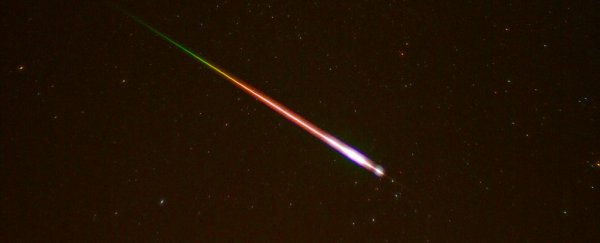Just in case you missed this week's amazing supermoon show, there's no need to beat yourself up about it, because the night sky is here to console you with another awesome spectacle.
Later tonight – or early tomorrow morning, depending on where you are in the world – the Leonid meteor shower will peak, as Earth passes into a stream of icy debris trailing in the wake of the comet Tempel-Tuttle.
When this happens, tiny pea-sized fragments of dust and ice in the comet's wake will collide with Earth's atmosphere at their greatest rate, streaking across the night sky at a rate of somewhere between 10 to 15 meteors per hour.
This viewable peak will occur at Thursday 6am EST (3am PT or 10pm AEDT), although the shower will continue until the end of the month.
About half of these Leonids will leave visible trails behind them as they burn up, so if you're in the mood to gaze (and maybe wish) upon some shooting stars, tonight's definitely the night.
As Joe Rao at Space.com explains, the timing of this year's Leonid meteor shower should be ideal for viewing across much of the US – especially for those living in the central and western regions, where the dawn of the morning sun won't have had a chance to drown out the light show.
But one factor that could affect Leonid visibility this year is the hangover from Monday's epic supermoon. The bright light emanating from the waning gibbous moon could make the fireworks harder to make out.
The reason the Leonids are one of the most famous meteor showers is because it's responsible for some of the biggest meteoric outbursts humankind has ever witnessed.
The annual shower reaches its zenith once every 33 years, when a particularly dense cluster of Tempel-Tuttle's debris crosses paths with Earth.
These peak outbursts – the last of which occurred in 2001 – typically see up to 1,000 meteors per minute shooting across the sky, with a particularly intense display in 1966 producing around 2,000 per minute.
Unfortunately, we're not in for a display like that in 2016 – but at a rate of no more than 20 per hour, there'll be plenty of time for skygazing in between the stargazing.
"This year, the Leonids are not in outburst, so the rates are going to be about 10 to 15 per hour," NASA meteor expert Bill Cooke told Hanneke Weitering at Space.com.
The next major outburst is scheduled to hit in 2034, but tonight's Leonids are still your best opportunity for some serious stargazing right now – that is, until the Geminids and Ursids in December.
The Leonids get their name from the constellation Leo, which sits in the northeastern part of the sky. But due to the shooting effect, Cooke says you don't need to look in any particular region of the sky to see them.
You also won't need any special equipment like binoculars or a telescope to see them – and in fact, it'd be easier to miss the streaking fireballs with a zoomed-in view.
But try to get away from any lights if you can, such as streetlights or light from buildings.
"[Let] your eyes hang loose and don't look in any one specific spot," NASA recommends. "Relaxed eyes will quickly zone in on any movement up above, and you'll be able to spot more meteors. Avoid looking at your cell phone or any other light."
And you will need patience, as each meteor will only be visible for a fleeting second.
"Go outside, find a dark sky, lie flat on your back and look straight up," Cooke told Space.com, "and be prepared to spend a couple of hours outside."
If weather, the Moon, or daylight spoil the show where you live, you can also catch the Leonids online, thanks to Slooh's livestream below:

